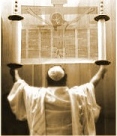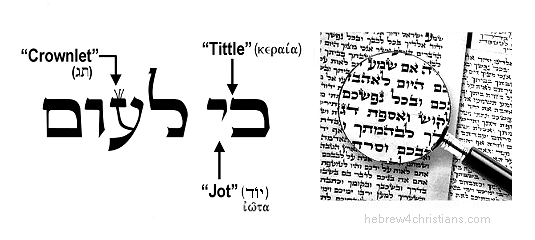|
|
|||||||||||||||||||||
 |
|||||||||||||||||||||
|
Learn Hebrew |
|||||||||||||||||||||
|
|
||||||||||||||||||||||||||||
 |
|
|
||||||||||||||||||||||||
|
During Simchat Torah (ū®ū×ūŚū¬ ū¬ūĢū©ūö) the last Torah portion (from Deuteronomy) is read as well as the first verses of the first portion (from Genesis), thereby indicating that Talmud Torah - the study of Torah - never ends. The idea that Torah study is cyclical finds expression in the ritual of dancing around and around the Torah, known as hakkafot (ūöū¦ūżūĢū¬). ū¢ųČūöųŠūöųĘūÖų╝ūĢų╣ūØ ūóųĖū®ūéųĖūö ūÖų░ūöūĢųĖūö ūĀųĖūÆų┤ūÖū£ųĖūö ūĢų░ūĀų┤ū®ūéų░ū×ų░ūŚųĖūö ūæūĢų╣ zeh-hai┬Ęyohm ah┬Ęsah Adonai nah┬Ęgee'┬Ęlah ve┬Ęnees┬Ęme┬Ęchah voh "This is the day that the LORD has made; let us rejoice and be glad in it" Note that the word "nagilah" (ūĀųĖūÆų┤ūÖū£ųĖūö) in this verse means "let us rejoice," from a root word "gil" (ūÆų╝ų┤ūÖū£) that means a "circle," suggesting the circle dance of the hakafah.
The Chidushei Haran said, "People think we rejoice on Simchat Torah because on this day we conclude the Torah. They are wrong. Our happiness stems from the fact that we are beginning the Torah all over again!" In this connection we recall the words of Yeshua given to his followers: "Do not think that I have come to abolish the Torah or the Prophets; I have not come to abolish them but to fulfill them. For truly, I say to you, until heaven and earth pass away, not the smallest stroke of the smallest letter Yod (ū¦ūĢų╣ū”ūĢų╣ ū®ųČūüū£ ūÖūĢų╣ūō), will pass from the Torah until all is accomplished. Whoever therefore breaks one of the least of these commandments, and teaches men so, shall be called least in the kingdom of heaven; but whoever does and teaches them, he shall be called great in the kingdom of heaven" (Matt. 5:17-19).
|
|
The Circle of Torah |
|
|
Note: For Simchat Torah, only part of Parashat Bereshit is read. The full parashah |
||||||
 |
||||||
 |
||||||
|
Shavuot and Simchat Torah |
||||||
|
Both major holiday periods (the Spring and the Fall) climax with a festival devoted to Torah:
However, even though both holidays center on Torah, the mood of the two holidays is altogether different. Shavuot is a time to soberly respond to the revelation of the Torah by committing ourselves to observe and study it, whereas Simchat Torah is a time to express our love and adoration for the Torah by rejoicing and dancing with it. |
 |
|
We do not celebrate Simchat Torah on Shavuot, because the Torah requires our response; nor do we celebrate it on Rosh Hashanah or Yom Kippur, since this represents a time of judgment and atonement. Therefore we wait until the end of the climactic feast of Sukkot to celebrate the Torah, wherein "you will be completely joyous" (Deut. 16:15). We celebrate the completion of the Torah by reading the blessing of Moses over the tribes of Israel (i.e., V'zot Haberakhah, the last portion of the Torah). |
|
Simchat Torah Services |
|
1. The Evening Service (ū®ūÖū©ūĢū¬ ū×ūóū©ūÖūæ) Simchat Torah celebrations begin after the normal Ma'ariv (evening) service in the synagogue, on Tishri 23. All of the synagogue's Torah scrolls (sifrei Torah) are taken from the Holy Ark and various people are given the honor of carrying a scroll during a festive processional called a hakkafah. There are seven of these hakkafot, or "circling processionals," that occur, and it is customary dance about and "kiss" the scrolls as they pass by touching a Siddur (prayerbook) to the scroll and then kissing the book. After the seventh circling, the scrolls are returned to the Ark, though one is left on the bima (Torah reading stand) to read the last Torah portion of the cycle. This is the only time of the year that the Torah is recited during an evening service. Everyone Invited to Aliyah... Torah Reading Service |
|
|
||||||||||||||||
|
Conclusion of the Morning Service |
|
Yeshua and Simchat Torah |
|
Since Yeshua the Mashiach (i.e., "Jesus Christ") is Torah Ha-Emet - the True Torah - we should likewise celebrate the Joy of Torah in our lives. Yeshua is the Living Torah, the Living Word, written upon our hearts so that we can truly dance and embrace the Truth given from God. Indeed, Yeshua did not come to destroy the Torah but rather to fulfill it in our lives (Matt. 5:17-20). As it is written in the Tanakh regarding the New Covenant: "Behold, the days come, saith the LORD, that I will make a new covenant (B'rit Chadashah) with the house of Israel, and with the house of Judah: Not according to the covenant that I made with their fathers in the day that I took them by the hand to bring them out of the land of Egypt; which my covenant they brake, although I was an husband unto them, saith the LORD: But this shall be the covenant that I will make with the house of Israel; After those days, saith the LORD, I will put my law (Torah) in their inward parts, and write it (the Torah) in their hearts; and will be their God, and they shall be my people. And no longer shall each one teach his neighbor and each his brother, saying, 'Know the LORD,' for they shall all know me, from the least of them to the greatest, declares the LORD. For I will forgive their iniquity, and I will remember their sin no more." (Jeremiah 31:31-34) |
 |
|||
|
Revealed in Torah |
|||
|
This very idea is clearly re-affirmed in the New Testament (see Hebrews 8:8-11). As Christians, then, we have the greater reason to celebrate Torah, since Yeshua (Jesus) is of course the heart, or central message of the Torah -- its inner meaning and incarnation. He is the Torah made flesh (John 1:14), the faithful Mediator of the New and Better Covenant (Hebrews 8:6), and He does what Moses and the Sinatic covenant could never do, namely, write the Torah within our inward parts and upon our hearts so that we might truly be the people of God (Jeremiah 31:31-34). By means of His sacrificial death, the righteous demands of Torah are fully satisfied, and the LORD is glorified as both just and merciful (i.e., the justifier of those who put their trust in Him). The Torah (i.e., law) is holy, just and good (Rom. 7:12), but those seeking righteousness based on it's demands will discover the tragic fact that it is powerless to impart righteousness and life (2 Cor. 3:7-18). It is sin within the human heart that condemns people - not the Torah. The crucifixion of Yeshua condemned sin in the flesh (again, it did not condemn the Torah) and now the righteousness of God is imparted to those who embrace Yeshua by faith (Rom. 8:3-4). Enabled by the Holy Spirit, with the Torah now written upon our hearts (Jer. 31:31-3; Heb. 8:10-11), we are empowered to fulfill the requirements of the law based on a new covenant relationship with God (Gal. 2:16, 3:2). We no longer seek righteousness by means of maintaining ritualistic or other ordinances (Rom. 4:5, Gal. 2:16) but by receiving the free gift of Messiah's righteousness imputed to us through our trust (Eph. 2:8-9). Because of Yeshua's victory, we do not strive for acceptance before the Father, we abide within it, chaverimŌĆ” |
 |
|||
|
Isru Chag (ūÉų┤ūĪų░ū©ūĢų╝ųŠūŚųĘūÆ) |
|||
|
The day following the closure of the Sukkot season is known as Isru Chag, "binding the festival" (from Psalm 118:27). It is observed as a semi-festive day, when the Tachanun supplications (normally recited after the weekday Amidah) are omitted from the morning and afternoon services. |
|
The LORD is God; He has given us light; bind the festal offering to the horns of the altar with cords. |
||||
|
El Adonai yaiyaer lanu isru-chag, b'avotim ad-karnot ha-mizbe'ach. |
||||
|
During the Temple period, Isru Chag was the day when the pilgrims would leave Jerusalem for their journey back home. According to the Talmud, observing Isru Chag as a festive day is akin to offering sacrifices upon the altar in the Temple (Sukkah 25b). |
|
|
|
||||||||||||||||||||
|
|
|||||||
|
Hebrew for Christians |
|||||||
|
|||||||









